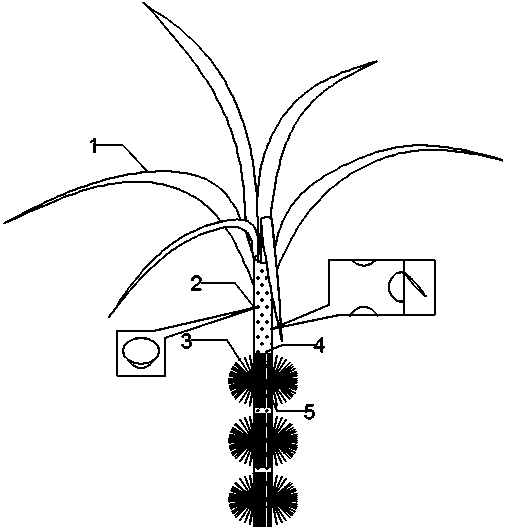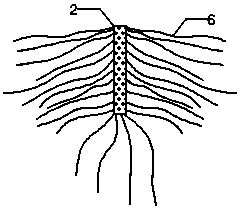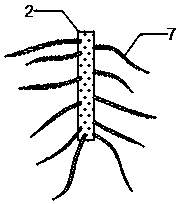Method for restoring degraded riparian zone through imitated vegetation
A technology of bionic plants and riparian zones, applied in water conservancy projects, coastline protection, restoration of polluted soil, etc., can solve problems such as difficult survival of plants, failure to use microorganisms, degradation of pollutants, etc., to prevent soil erosion, simple manufacturing, The effect of easy installation
- Summary
- Abstract
- Description
- Claims
- Application Information
AI Technical Summary
Problems solved by technology
Method used
Image
Examples
Embodiment
[0031] Such as figure 1 , 2 Shown in , 4, the long 20cm diameter 5cm of stem part, insert soil upright, have a large amount of ventilating apertures of diameter 0.5cm on the stem, have the small lid of oblique 45 ° on the aperture, prevent ventilating aperture from clogging up. The bionic leaves are 15cm long and 5cm wide, and a total of 6 pieces are fixed on the top of the stem. The root length of the stem is 10cm, and it is connected with the stem by thread. According to the soil condition, the short root and the long root are arranged in a ratio of 1:1. The short root is composed of a large number of extremely fine filler filaments, the filler filaments are 5cm long, and hundreds of them are fixed at the root of the stem, which can attach and cultivate microorganisms, and the filler filaments can also filter and intercept pollutants. The long roots are 20-30cm long, and nearly a hundred long roots are fixed at the root of the stem, which can increase the strength of the s...
PUM
 Login to View More
Login to View More Abstract
Description
Claims
Application Information
 Login to View More
Login to View More - R&D
- Intellectual Property
- Life Sciences
- Materials
- Tech Scout
- Unparalleled Data Quality
- Higher Quality Content
- 60% Fewer Hallucinations
Browse by: Latest US Patents, China's latest patents, Technical Efficacy Thesaurus, Application Domain, Technology Topic, Popular Technical Reports.
© 2025 PatSnap. All rights reserved.Legal|Privacy policy|Modern Slavery Act Transparency Statement|Sitemap|About US| Contact US: help@patsnap.com



